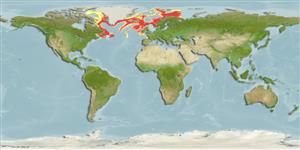Preferred temperature (Referencia
123201): 0.7 - 9.5, mean 3.6 °C (based on 707 cells).
Phylogenetic diversity index (Referencia
82804): PD
50 = 0.5000 [Uniqueness, from 0.5 = low to 2.0 = high].
Bayesian length-weight: a=0.00302 (0.00141 - 0.00645), b=3.24 (3.07 - 3.41), in cm total length, based on LWR estimates for this (Sub)family-body shape (Ref.
93245).
Nivel trófico (Referencia
69278): 3.4 ±0.2 se; based on diet studies.
Resiliencia (Referencia
120179): Bajo, población duplicada en un tiempo mínimo de 4.5-14 años (Fec assumed to be <100).
Fishing Vulnerability (Ref.
59153): Moderate vulnerability (44 of 100).
🛈
Nutrients (Ref.
124155): Calcium = 5.49 [0.80, 107.06] mg/100g; Iron = 0.328 [0.031, 4.452] mg/100g; Protein = 15.1 [13.0, 17.1] %; Omega3 = 0.494 [0.195, 1.253] g/100g; Selenium = 17.8 [3.1, 85.5] μg/100g; VitaminA = 4.75 [0.34, 63.37] μg/100g; Zinc = 0.305 [0.021, 3.468] mg/100g (wet weight);
